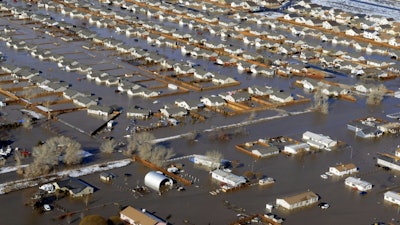
FERNLEY, Nev. (AP) — A conflict emerging on northern Nevada's high desert marks an unusual crossroads for a pandemic, a relic of American westward expansion and 21st century technology.
The townspeople of rural Fernley are fighting government plans to renovate a century-old earthen irrigation canal that failed and flooded hundreds of homes in 2008.
They say the U.S. Bureau of Reclamation's plan to make the canal safer would leave 450 people without access to domestic wells they rely on as their sole source of water.
Citing the coronavirus crisis, they want a U.S. judge to intervene in the controversy driven largely by the Trump administration’s efforts to expedite — critics say short-circuit — environmental reviews that slow approval of energy exploration, mine expansions and other development on federal lands.
At issue is the bureau's refusal to extend a public comment period beyond April 20 on plans for the canal built in 1905 — part of the first major project in the West to “make the desert bloom.”
“Unfortunately, in the name of protecting Fernley, Reclamation is now planning a maintenance project that will destroy Fernley’s groundwater supply,” attorney Paul Taggart said in April 9 court filings in Reno reviewed by The Associated Press.
“Because of Reclamation’s baffling intransigence during a time of unprecedented national emergency, and to protect its at-risk citizens right to participate in the administrative proceedings... Fernley files this emergency petition.”
Residents of the town 30 miles (48 kilometers) east of Reno say they couldn’t attend public meetings on the bureau's draft environmental statement scheduled March 24-25 due to Gov. Steve Sisolak’s statewide prohibition of gatherings of more than nine people.
It says the “outrageousness” of the bureau's refusal to grant an extension is underscored by recent waivers of similar deadlines by the Forest Service and Bureau of Land Management for comment on forest management plans and sage grouse protection strategies.
On April 6, the same day the Bureau of Reclamation denied Fernley’s request, the Bureau of Land Management announced the extension of public comment for six draft supplemental environmental impact statements for grouse habitat in seven Western states. It was granted based on the same national emergency driving Fernley’s plea, the petition states.
Likewise, on March 19, the Forest Service extended public comment for national forest plans in North Carolina because previously scheduled meetings were cancelled due to the pandemic.
The bureau said in denying the request that residents still can download the documents and offer comments online.
But Fernley officials say many of those affected are elderly, disabled and low-income residents least likely to have access to computers or sufficient skills to participate online. They note the virus outbreak has closed libraries and other places people without computers normally could access the internet.
William Jones, 71, is among those who own computers but are “very limited” in their ability to use the internet. “I would call myself `computer illiterate,'” Jones said in an affidavit.
Judge Miranda Du has ordered the agency to respond by Wednesday and scheduled a status hearing by telephone Thursday.
Bureau Area Manager Terri Edwards said in denying the request that the agency is “making reasonable accommodations under the circumstances.”
The "virtual public meeting website” available since March 24 allows visitors to read project information, ask questions and provide comments. It also allows people to request copies of documents, Edwards wrote April 6.
It's not the first time the canal has been the subject of litigation. The Truckee-Carson Irrigation District that manages the canal system agreed in 2016 to a $18.1 million class-action settlement with 1,200 victims of a flood that damaged 590 homes in 2008.
Unusual, heavy winter rain put pressure on the canal system that experts later determined had been weakened by decades of rodents burrowing into the sides of the earthen embankments.
Fernley advocates fortifying the walls by lining them. But it opposes the government's alternative to extend the lining to the bottom of the canal, preventing normal seepage into the aquifer accessed by domestic wells.
The residents argue the bureau arbitrarily rushed out its plans to take advantage of the shortened comment period after breaking its own rules by not completing environmental studies within a year. The bureau began studying canal repairs in 2015.






















